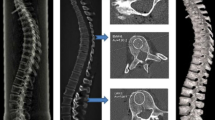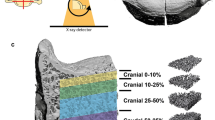Abstract
The penetration strength of trabecular bone tissue of human lumbar vertebrae was determined in vitro by the osteopenetrometer. The tests were performed in the frontal, middle, and back third of the vertebra body lateral side, in the upper and lower terminal plates, and in the processus spinosus in three vertebrae of the age group 1 (19–25 years), four vertebrae of the group 2 (40–60 years), and four of the group 3 (61–75 years). The data obtained show that the penetration of strength of the human lumbar vertebrae diminishes with age nonuniformly: the most expressed decrease appears in the frontal and middle parts of the lateral side and in the processus spinosus, but very little change appears under the terminal plates. The significant correlation between the penetration strength in the processus spinosus and in the vertebrae body could be useful for diagnostics of the vertebra state in vivo. According to the measured penetration strength in the processus spinosus, it is possible to indirectly estimate its value in the vertebra body.
Similar content being viewed by others
References
P. J. Atkinson, “Variation in trabecular structure of vertebrae with age,” Calc. Tissue Res.,1, 24–32 (1967).
M. Kleenekoper, S. A. Goldstein, L. A. Feldkamp, M. J. Flynn, D. Dickie, and A. M. Parfitt, “Cancellous bone architecture and bone strength.” in: C. Christiansen, J. S. Johansen, and B. J. Riis (eds.), International Symposium “Osteoporosis 1987,” Vol. 1, Viborg, Denmark (1987), pp. 294–300.
W. A. Kalender, E. Klotz, and C. H. Suess, “Vertebral bone mineral analysis: an integrated approach with CT,” Radiology,164, 419–423 (1987).
I. Hvid, K. Andersen, and S. Olsen, “Cancellous bone strength measurements with the osteopenetrometer,” Eng. Med.,13, 73–78 (1984).
I. Hvid, “Cancellous bone at the knee: a comparison of two methods of strength measurement,” Arch. Orthop. Traumative Surg.,104, 211–217 (1985).
V. Logins, Cancellous bone strength measurements with the osteopenetrometer,” in: Abstracts of the 1st Congress of the Lithuanian Society of Traumatology and Orthopaedics, Klaipeda, Lithuania (1992), pp. 64–65.
S. D. Rockoff, E. Sweet, and J. Blaustein, “The relative contribution of trabecular and cortical bone to the strength of human lumbare vertebrae,” Calc. Tissue Res.,3, 163–175 (1969).
V. Logins, “Osteopenetrometer — the device and method for investigation of cancellous bone tissue,” in: Proc. of 1st All-Russia Conference-Fair “Biomechanics in Protection of Human Life and Health” [in Russian], Vol. 2, Nizhnii Novgorod. Russia (1992), p. 166.
K. G. Faulkner, C. E. Cann, and B. H. Hasegawa, “Effect of bone distribution on vertebral strength: assessment with patient-specific nonlinear finite element analysis,” Radiology,179, 669–674 (1991).
R. B. Mazess, P. Pedersen, J. Vetter, and H. S. Barden, “Bone densitometry of excised vertebrae, anatomical relationships,” Calc. Tissue Int.,48. 380–386 (1991).
T. Sandor, D. Felsenberg, W. A. Kalender, and E. Brown, “Regional analysis of the loss of bone mineral density from spinal cortical bone,” Radiology, Suppl. 185, 266 (1992).
M. Ito, K. Hayashi, Y. Kawahara, M. Vetani, and Y. Imaizumi, “The relationship of trabecular and cortical bone mineral density to spinal fractures,” Invest. Radiology,28, 573–580 (1993).
B. D. Snyder, S. Piazza, W. T. Edwards, and W. C. Hayes, “Role of trabecular morphology in the etiology of agerelated vertebral fractures,” Calc. Tissue Int.,53, Suppl. 1, 14–22 (1993).
S. Struhl, S. A. Goldstein, D. L. Dickie., M. J. Flynn, and L. S. Matthews, “The distribution of mechanical properties of trabecular bone within vertebral bodies and iliac crests: correlation with computed tomography,” Trans. Actions of 33rd Orthop. Res. Soc., Vol. 12 (1987), p. 262.
T. S. Keller, T. H. Hansson, A. S. Abram, and D. M. Spengler, “Regional variations in the compressive properties of lumbar vertebrae trabeculae: effect of disc degeneration,” Spine,14, 1012–1019 (1989).
Li. Mosekilde, Le. Mosekilde, and C. C. Danielsen, “Biomechanical competence of vertebral trabecular bone in relation to ash density and age in normal individuals,” Bone,8, 79–85 (1987).
V. Logins, “The changes of the penetration stress of the vertebra spongiosa of sportsmen during intensive physical loads,” in: Abstracts of the 2nd Congress of the Lithuanian Society of Traumatology and Orthopaedics, Vilnius, Lithuania (1994), p. 106.
Li. Mosekilde, “Normal aged-related changes in bone mass, structure, and strength—consequences of the remodeling process,” Dan. Med. J.,40, 65–83 (1993).
R. B. Mazess, “Fracture risk: a role for compact bone,” Calc. Tissue Int.,47, 191–193 (1990).
P. Brinckmann, M. Biggermann, and D. Hillweg, “Prediction of the compressive strength of human lumbar bertebrae,” Spine,14, 606–610 (1989).
Additional information
Latvian Medical Academy, Riga, Latvia. Published in Mekhanika Kompozitnykh Materialov, Vol. 32, No. 4, pp. 564–573, July–August, 1996.
Rights and permissions
About this article
Cite this article
Logins, V., Pontaga, I. & Saulgozis, J. Vertebrae cancellous bone strength measurements by an osteopenetrometer. Mech Compos Mater 32, 391–397 (1996). https://doi.org/10.1007/BF02254754
Received:
Issue Date:
DOI: https://doi.org/10.1007/BF02254754




